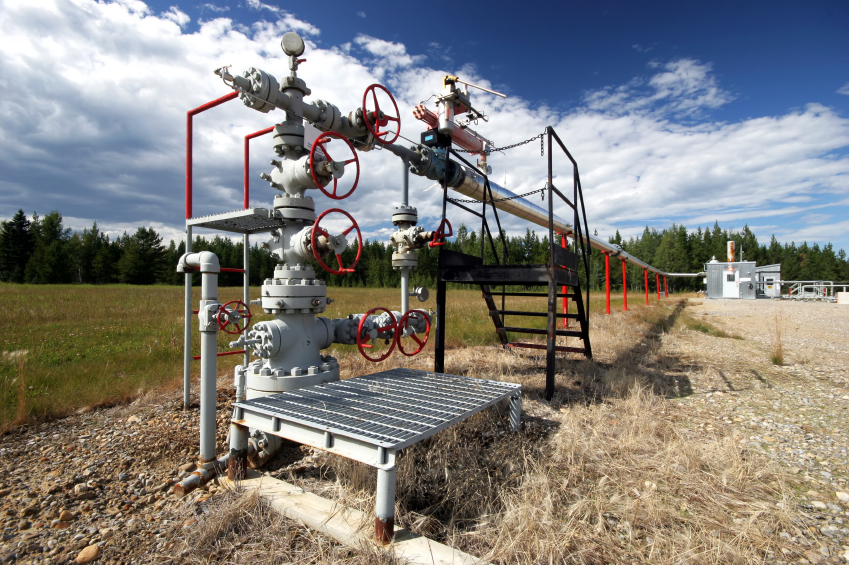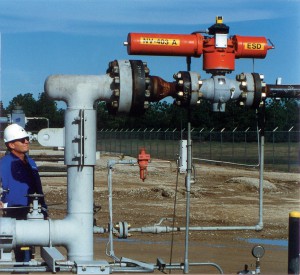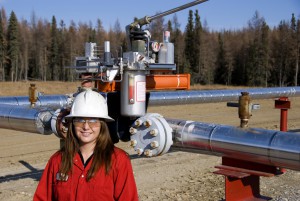February 2014, Vol. 241 No. 2
Features
Emergency Valve Shutdown Solutions In Shale Plays

Production from natural gas and liquids rich shale plays in the United States is booming. In the past five years alone, shale gas reserves have increased tenfold to 25 Bcf/d. Similarly, tight oil production has risen to 1.8 MMbcf/d, more than 600% over that same period [1]. This prolific growth trend has created a dramatic need for infrastructure improvements, including transport via pipeline from the wellhead to processing facilities and beyond.
Often, shale well pads and various flow lines are located in remote areas where human monitoring is not cost-effective or practical. If a pipeline anomaly occurs requiring shutdown, response time is of the essence to contain the leak or rupture. Manual shutdown – dependent on traveling to the valve site, identifying the problem and arresting flow – is usually too time-consuming to be a feasible option.
In addition to financial losses, potential damage to the environment is a major concern of all producers. Therefore, automated valves for emergency shutdown (ESD) and process shutdown (PSD) are required as being key to personnel safety, asset protection and environmental preservation. These can be activated without human intervention using a pre-selected ESD “trip” device or command from a remote central control location.
Various drivers, including regulations at all governmental levels, geographic location and available power sources, all affect the choice of solutions available for automated emergency or process shutdown. Different pipeline segments, from the wellhead and gathering to transmission lines, require choices from a variety of technological alternatives for immediate and safe shutdown.
Safety Instrumented Systems
Safety Instrumented Systems (SIS), designed for bringing a flow or process to a safe state, are comprised of logic solvers, sensors and final control elements as the primary components. These system components normally include a spring-return or a gas-powered actuator (final control elements) and act in concert with each other to immediately operate a valve when pre-determined conditions are met. The existence of a SIS is especially important when a field is remote or unmanned – dependability is crucial when required. Valves and automation components often remain in a static position until a trip signal requires the equipment to operate the valve. When needed, performance must be flawlessly to immediately shut off or divert flow or else disaster could take place.
Power Sources For Actuators
All actuators need some type of power source to transfer energy into a motion in order to drive a valve to its safe state. There are several basic sources of power available:
Manual power – This is normally in the form of a manual hydraulic pump, which with human effort can create energy to compress the spring of a spring-return actuator. This means of shutdown is usually used when no other suitable form of power source is available or practical. This is not to be confused with a manual “override” system.

Direct pneumatic, gas or a gas-stored supply – In this service, instrument air or a gas supply derived from the media in the valve (normally natural gas), nitrogen bottle or other suitable pressure vessel can provide the needed energy to operate the valve. A gas motor or gas-powered actuator, such as a gas-over-oil unit, are often used in these applications. This source can also be used to compress a spring in a spring return actuator for mechanical fail safe applications.
Hydraulic direct power – Direct hydraulic power in the form of a power unit normally requires an electric supply to power a hydraulic pump, compressing a spring or storing hydraulic energy in a storage vessel (accumulator).
Electric – Electrically powered units are not generally found in SIS ESD applications but can often be found in PSD applications. A charged battery storage bank can be used to provide a backup power source.
Electric hybrid – Electro-hydraulic actuators typically rely on an electric power source to create hydraulic pressure for compressing a mechanical spring.
Configurations for Fail Mode Tripping
There are numerous ways that automation solutions can be configured to respond to trip an ESD or PSD signal. Among them:
Solenoid valve – The system can be remotely or locally shut down by an electrical signal that de-energizes the solenoid valve or valves. A few applications exist where energizing is required.
Supply pressure loss – This shutdown mode is usually performed by a piloted control valve that has similar functionality to a solenoid valve except that it trips upon loss of a pressure supply.
High/low pressure pre-set – This method uses one or two pressure pilot valves (high and/or low). These are installed at various points on the flow lines to automatically trigger a valve shutdown when a pre-set overpressure limit is exceeded or the sensed pressure falls below a given value. Spurious trips can often be avoided with when using pressure-sensing pilots if linebreak systems are incorporated that measures pressure deviations over time, allowing for temporary pressure fluctuations within a pre-determined period of time.
High temperature shutdown – A temperature sensing device, often a fusible plug, can be installed to shut-in the valve and vent pressure when a pre-set temperature limit is reached.
Wireless – Wireless technology, gaining increased use in many industrial applications, can be used to monitor a valve and flow lines and transmit an alarm or signal for field position recognition. This technology has not been generally accepted for use in safety-related ESD applications.
Hybrid – One or more of the configurations can be combined for redundancy or sequential use.
API 6A Applications
At the Christmas tree, the API 6A standard generally applies for manual and automated valve design and functionality. Many factors affect the chosen solution and vary according to the pressures, flow rates, temperatures and fluid composition in the various shale plays. The 6A production or flow wing valves for ESD/PSD service on the Christmas tree are usually of the reverse-acting gate design suited for operating pressures between 2,000-15,000 psig. The valves are typically located upstream of the production choke and may or may not be automated.
When automated, some shale producers are placing these 6A ESD valves on the downstream side of the choke to further protect equipment from choke failure due to unanticipated washouts or slugs. If not shut-in, processing equipment, including heat exchangers or production separators, could be damaged.
While traditional operation of API 6A valves has been powered by hydraulic or compressed air power, a newer development has seen an acceptance of 6A gate and ball valves with manual hydraulic, self-contained shutdown systems. The increased demand for this technology has been driven, in part, by best practices in the field, the remoteness of many well pad locations and the lack of experienced manpower to operate the tremendous increase in shale wells.
The self-contained, manually powered units offer ESD/PSD protection with no addition to existing power supply infrastructure. The units can be configured to not rely on an external power source. Rather, they are powered by a hydraulic hand pump located at the actuator. Therefore, the setup is adaptable for shutdown when alternate power sources are not dependable or unavailable in almost any application.

API 6D Applications
The API 6D specification for pipeline valves is generally applicable beyond the Christmas tree and production choke valve to provide ESD/PSD protection for shale flow lines from gathering points, to processing operations for separation and treating, and onto storage facilities and custody transfer stations. At all points along this travel, the flow lines are susceptible to rupture, overpressure, backflow and hazards that require immediate shutdown.
Often the lines travel considerable distances between the facilities through remote areas that require automated shutdown capabilities. The quarter-turn ball valve is predominantly found in this service. Automated check, gate, plug and butterfly valves are also used.
The technologies used at or near the well for 6A shutdown are basically the same used in 6D applications. Other than special valve considerations and power source availability issues, there are few differences in the basic automation functionality between 6A and 6D use.
Conclusion
Shale plays continue to be viewed as a likely solution to the United States’ efforts to become energy self-sufficient. Shale production has created a dramatic increase in the number of wells produced and the associated infrastructure. Much of this activity is taking place in regions that have had little or no previous activity. Often, operators are not prepared with sufficient infrastructure and manpower to manually monitor well activity or intervene in shutting down pipeline anomalies. With the industry spearheading positive safety, asset and environmental protection solutions through technology, reliance on automated ESD and PSD valves and actuators will continue to play a growing and prominent role.
Author: Tom Jeansonne is the Bettis Energy sales manager for Emerson Process Management, Valve Automation based in Houston. He has more than 35 years’ experience in valve automation, including technical, training, application and sales support for end users, sales channels and valve OEMs. He can be reached at tom.jeansonne@emerson.com.





Comments